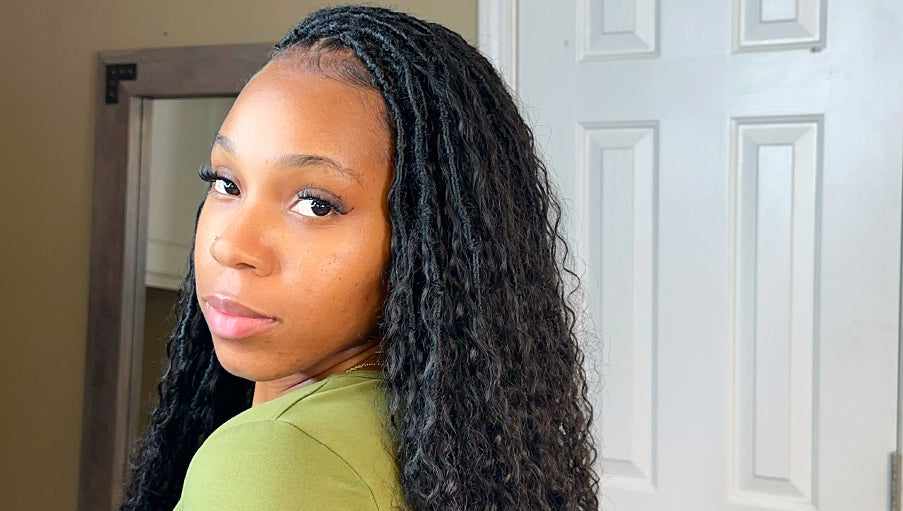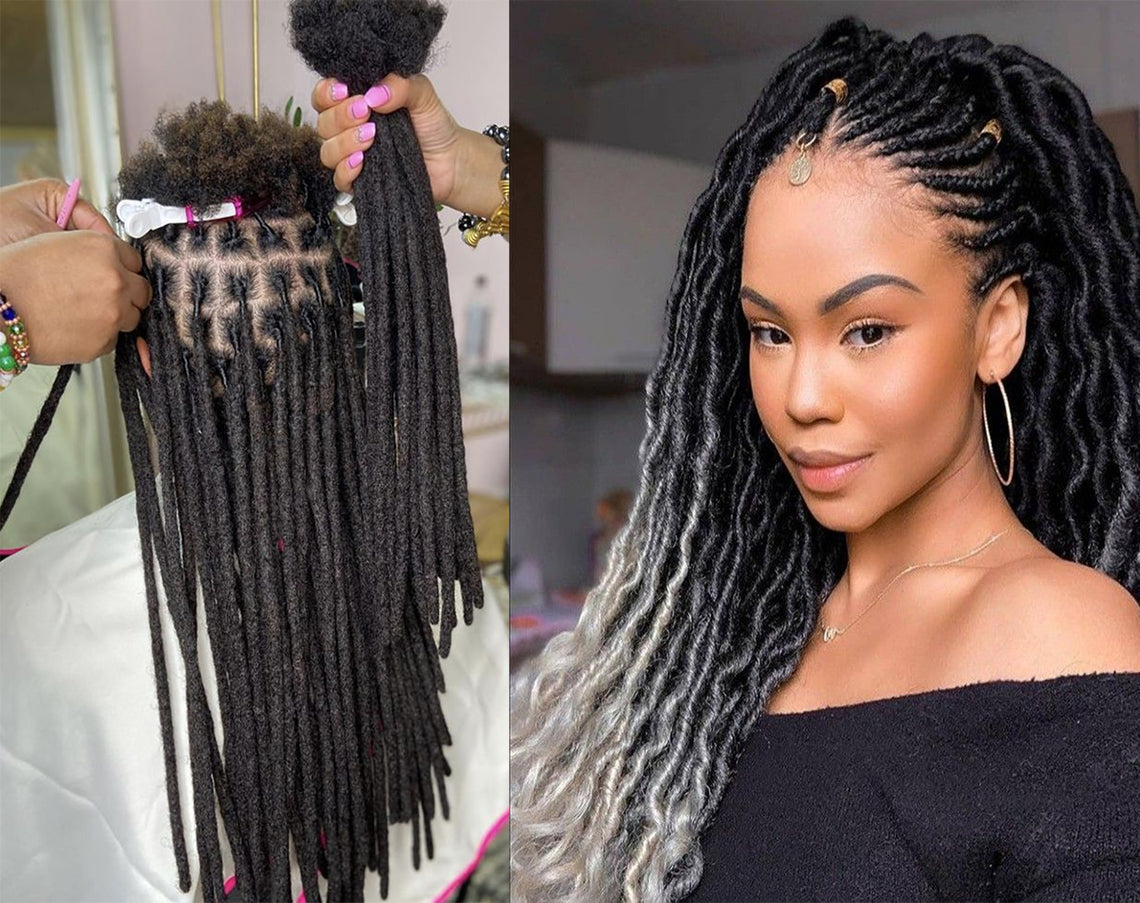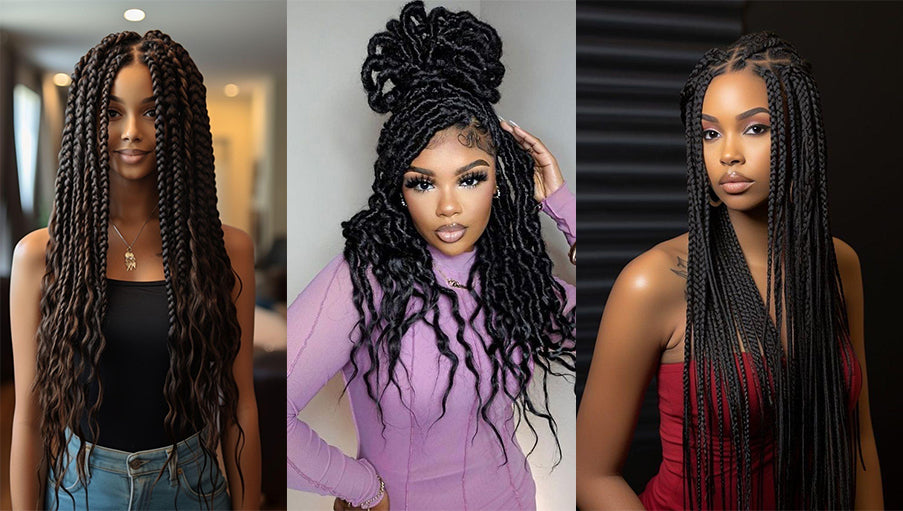What Are the Different Types of Dreadlocks?

Dreadlocks are one of the most versatile hairstyles in the world! You can braid, twist, or pack them in a ponytail. They’re also easy to maintain and have a way of adding personality to a face. In our opinion, they are the perfect hairstyle! In this article, we’ll be looking at 8 types of dreadlocks, their pros, cons, and how to maintain them.
Let’s get started!
Sisterlocks
Meaning of Sisterlocks
Sisterlocks are a form of structured dreadlocks. They are usually 2-3 mm in size (that is, roughly the size of a toothpick). They are versatile, look like micro braids, and support most hairstyles. They are also compatible with crochet, box braids, ponytails, and most weaving hairstyles because of their size.
Advantages of Sisterlocks
- You can style them however you like (for example you can make them into box braids).
- They look like loose hair or micro braids most of the time.
- You can curl or flatten sisterlocks with a curling iron or hot comb because of their size.
- They are lighter than traditional locs. In most situations, they don’t feel any heavier than loose hair.
Maintenance of Sisterlocks
As great as sisterlocks are, you still need to do the following to make sure the hairstyle is a hundred percent all the time. These things include:
- Retightening your hair every four to six weeks. This should be done by a loctician because sisterlocks are made with special techniques that unqualified persons may not be able to replicate;
- Washing your hair every four to six weeks to keep it gunk and residue-free;
- Using a silk bonnet or pillow at night to prevent your locs from becoming dry and frizzy;
- Using a deep conditioner or cream after you wash your hair to reintroduce moisture back into it and keep your hair healthy;
- Oiling your scalp after washing to prevent it from drying out.
Tips for Sisterlocks
- Sisterlocks are very technical locs. As a result, it’s important to make sure it’s done by a certified loctician to get exactly what you want.
- We know we said you can use a hot comb and curling iron to style them but don’t use heat tools on your sisterlocks if you can help it. Sisterlocks are very fragile and may break off with too much heat.
Traditional Locs
Meaning of Traditional Locs
These are the most common locs. At 5-14mm, they’re usually about the size of one or two fingers. Unlike sisterlocks, traditional locs don’t have as many styling options and they can’t be flat-ironed.
Advantages of Traditional Locs
- These are the most common types of locs.
- You can start and maintain them at home yourself without any stylist.
- They don’t need much maintenance.
- They come in different sizes so you can choose what fits your facial structure.
- They are cheaper than sisterlock.
- You can easily convert them to freeform locs if you get tired of them down the line.
Maintenance of Traditional Locs
- Your locs go through five phases from starter to maturity and throughout all these stages, you need to follow the processes below to maintain it.
- Wash your hair with gentle shampoo to get rid of the product buildup on your locs and scalp every two weeks.
- Apply conditioner and leave in conditioner to your locs generally but don’t be heavy handed with them.
- Dry your locs properly to prevent them from having a funky smell.
- Put oil on your scalp.
- Retwist your locs occasionally to make them neater.
Tips for Traditional Locs
- You can’t curl traditional locs with a curling iron because of their sizes but you can still use pipe curlers and rollers to create curls.
- Don’t overwash your locs to prevent them from breaking.
Semi-Freeform Locs
Meaning of Semi-Freeform Locs
These locs are usually the same size as traditional locs. The only difference between semi-freeform locs and traditional locs is that they’re allowed to grow freely and the retwisting periods are further apart. This gives the locs the opportunity to grow as big and thick as they possibly can.
Advantages of Semi-Freeform Locs
- You don’t have to maintain the roots as often.
- You don’t need a stylist to start.
- The locs are bigger and thicker.
- The hairstyle is cheap to maintain because you don’t have to visit as many stylists.
Maintenance of Semi-Freeform Locs
- Shampoo your hair once or twice a week or in two weeks.
- Air dry or dry under a machine.
- Moisturize your hair with conditioner and oil.
Tips for Semi-Freeform Locs
- Don’t skip out on scalp cleansing because product buildup can negatively affect your locs.
- Oil-based products are likely to stick to your locs and weigh them down. So, choose water-based products such as leave-in conditioners to hydrate your hair.
Freeform Locs
Meaning of Freeform Locs
Freeform locs are exactly what they sound like. It's a type of loc that forms organically. You don't have to retwist or manipulate them. All you need to do is give the minimum required maintenance and let them grow freely.
The size of freeform locs depends on the density of your hair and how tight your natural curl pattern is.
Advantages of Freeform Locs
- You can do them by yourself at home.
- They don’t require as much maintenance as other types of locs.
- They don’t require much manipulating so your hair can grow in peace.
Maintenance of Freeform Locs
- Wash your freeform locs once or twice a week with a sulfate-free shampoo.
- Rinse, condition and moisturize with oil.
Tips for Freeform Locs
- Apple cider vinegar is great for getting rid of product buildup and cleansing your scalp.
- Avoid products with silicon because it makes your hair dry.
- Don't over wash or over manipulate your hair.
Instant Locs
Meaning of Instant Locs
You can create this loc style with either a crochet style or backcombing. It’s also the only dreadlock style that doesn’t go through a starter phase. With instant locs, you can start rocking your hairstyle immediately as soon as possible.
Advantages of Instant Locs
- Instant locs are great for people who are transitioning from relaxed hair to dreadlocks.
- They make it easier for people with straight hair or loose curl patterns to make dreadlocks.
- The hairstylists/locticians use a manual hair locking process that gives you the option to either create curly, goddess or straight locs.
Maintenance of Instant Locs
- Wash your instant locs every three to four weeks in the beginning to prevent them from unraveling.
- Moisturize your scalp often but pay attention to buildups. Use apple cider vinegar or baking soda in your routine to get rid of the gunk.
- Wear satin bonnets to lock in moisture and prevent lint from settling on your hair.
Tips for Instant Locs
- While you can wash your hair immediately after you make instant locs, not drying it properly will make it moldy.
Microlocs
Meaning of Microlocs
Microlocs are as small as sisterlocks. They're also the size of microbraids. However, they're easier and cheaper to make because they don't follow a grid pattern and you can create them with any hair-locking technique. Microlocs offer all the pros of sisterlocks without any of its cons. If you want something that looks like sisterlocks without breaking the bank, this look is your best option.
Advantages of Microlocs
- Microlocs are neater when you maintain them properly.
- You don’t need trained locticians to make microlocs.
- You can create microlocs with any hair-locking technique.
- Microlocs are versatile and you can style them easily.
- It doesn’t cost as much as sisterlocks to make.
Maintenance of Microlocs
- Wash your hair at least once or twice a week or biweekly.
- Moisturize your hair and scalp with oil and hair conditioner.
- You should schedule retightening appointments with your loctician or hairstyle once every six to eight weeks to prevent the hair from getting rough.
Tips for Microlocs
- Overstyling and manipulating your microlocs can lead to tension-induced alopecia, so style it carefully.
- Maintain your hair religiously to prevent it from thinning, matting and tangling.
Two Strand Twist Locs
Meaning of Two Strand Twist Locs
Two strand twists are not loc types. Rather, they’re loc techniques to create all the types of locs we’ve previously mentioned. They also take longer (about 6 to 9 months) to fully mature into locs, depending on your hair type.
Advantages of Two Strand Twist Locs
- They look like mini-twists rather than locs.
- You can start them at home if you know how to make twists by yourself.
- They’re the ultimate protective hairstyle because they can help your hair lock in moisture.
- They look good with most hairstyles. They are also good for long hair.
- Once they swell up, the locs they create are usually thick and luscious.
Maintenance of Two Strand Twist Locs
- You should protect the twists with satin bonnets or scarves to prevent them from drying out.
- Don’t wash your starter twists immediately after you make them.
Tips for Two Strand Twist Locs
- Two strand twists are great at retaining moisture. So, don’t over moisturize your hair while you have them.
- Use a dreadlock or clarifying shampoo to get rid of oil residue from other hair products every time you moisturize your hair.
- Twists can take a long time before they become locs. Our advice is to use a dread accelerator to fasttrack the process.
Interlocking Locs
Meaning of Interlocking Locs
Just like two strand twist locs, interlocking locs are not loc types per se. Rather, they’re locking techniques. However, they’re very versatile. They’re not just great for starter locs, they’re also perfect for maintaining existing locs. Some people call it root-flipping or latch-hooking because of the way it’s made.
To create interlocking locs, your hairstylist or loctician will divide your hair into sections, take each of those sections, backcomb to give it volume and use the three or four point rotation to make the partitioned sections look like locs and enhance growth.
Advantages of Interlocking Locs
- The locs from this technique are very durable.
- The locs are very uniform and stylish.
- You don’t need any hair product to make the hair and there are no sticky residues either.
- Interlocking locs can serve as a pick-me-up for your existing locs.
- It improves hair growth and blood circulation to your scalp.
Maintenance of Interlocking Locs
- You should go for regular touch-ups every four to eight weeks to keep your locs healthy.
- You need to wash and moisturize your hair every one or two weeks to keep it hydrated and gunk-free.
Tips for Interlocking Locs
- Make sure your hair isn't dry when you're interlocking to prevent breakage.
- Avoid tight styling to erase all chances of getting tension-induced alopecia.
- Ripping any hairstyle, especially your locs, is an absolute no because it can cause traction alopecia.
- If you must separate or loosen your locs, go to a stylist or qualified loctician.
Final Thoughts
You can't go wrong with whatever type of loc you choose, but you can go wrong with a loctician. Dreadlocks are long-term hairstyles. So, you want to make sure your foundation is right. Our advice is that you see a stylist or loctician before you start anything, even for loc styles you can make by yourself at home.We hope this article helps you on your loc journey!















